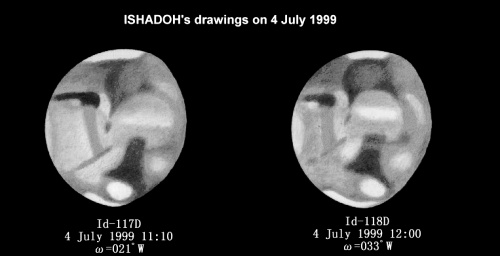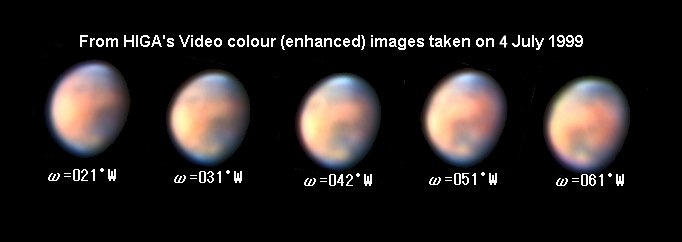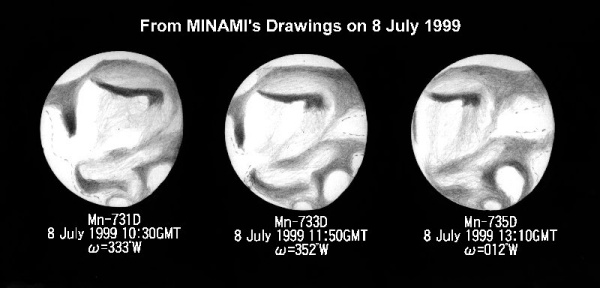
We first note that the early morning cloud was detected by ISHADOH (Id) on 29 June (162°Ls) when M Acidalium came into sight from our side:
29 June (162°Ls) Apparent Diameter=11.6", Phase Angle=39°, Central Latitude=23°N
Id-108D 11:00 GMT LCM =066°W Id-109D 11:40 GMT LCM =075°W Id-110D 12:20 GMT LCM =085°W Id-111D 13:00 GMT LCM =095°WThese range in longitude from LCM =066°W to LCM =095°W every ten degrees, and show that the morning cloud patch moved very slowly compared with the rotation of M Acidalium. Furthermore the position of the cloud remains in the early morning far from M Acidalium.
On 30 June (163°Ls), Id, IWASAKI (Iw) and MURAKAMI (Mk) observed, but not detected the morning cloud. Mk's observations at LCM =051°W(10:40GMT) and LCM =078°W show that the north polar mist was large, and Id also observed that the npc was obscure and the np region looked largely faint at LCM =088°W (13:10GMT) and so on.
Slightly earlier on the day the GMS detected a occurrence of a dust disturbance near the perimeter of the npc at 06:52~12:10 GMT (cf #222 p2585).
We made 11 observations on 1 July (163°Ls) starting from LCM =034°W to LCM =083°W as listed (where the codes Id, Mn, Mk and Nj imply ISHADOH, MINAMI, MURAKAMI and NAKAJIMA respectively).
1 July (163°Ls) Apparent Diameter=11.5", Phase Angle=39°, Central Latitude=23°N
Mn-712D 10:10 GMT LCM =034°W Nj-427D 10:30 GMT LCM =039°W Mk-181D 10:50 GMT LCM =044°W Mn-713D 10:50 GMT LCM =044°W Mn-714D 11:30 GMT LCM =054°W Id-114D 12:00 GMT LCM =061°W Mk-182D 12:10 GMT LCM =064°W Mn-715D 12:10 GMT LCM =064°W Id-115D 12:40 GMT LCM =071°W Mn-716D 12:50 GMT LCM =073°W Mn-717D 13:30 GMT LCM =083°WWhen M Acidalium was near the CM, the npc was quite obscure (by Mn). Id also drew the npr to be largely light. This might have been because of the dust disturbance, but it is noted that the npr was rather whitish (Mk and Id remark that it was blue-whitish). The npc became visible after Mn-716D (LCM =073°W).
On 2 July (164°Ls), no other person observed than Id only at LCM =040°W (Id-116D):
2 July (164°Ls) Apparent Diameter=11.4", Phase Angle=40°, Central Latitude=23°N
Id-116D 11:10 GMT LCM =040°WThe north of M Acidalium had two patches; the one to the south of the npc is misty in a elliptically roundish form.
There was not obtained any observation because of the cloudy sky any place on 3 July.
HIGA (Hg) joined in taking a series of Video images on 4 July (165°Ls): He produced images at LCM =021°W, 031°W, 042°W, 051°W and 061°W. Here we also reproduce two drawings by Id at LCM =021°W and LCM =033°W.
4 July (165°Ls) Apparent Diameter=11.2", Phase Angle=40°, Central Latitude=22°N)

Mk-183D 10:40 GMT LCM =013°W Hg-1-47V 11:12 GMT LCM =021°W Id-117D 11:10 GMT LCM =021°W Hg-2-47V 11:50 GMT LCM =031°W Id-118D 12:00 GMT LCM =033°W Hg-3-47V 13:38 GMT LCM =042°W Hg-4-47V 13:14 GMT LCM =051°W Hg-5-47V 13:53 GMT LCM =061°WTo the north of M Acidalium is clearly seen a yellowish white cloud patch whose outburst is more extensive than on 1 July.
The series by Hg show that the patch gradually entered inside the disk. The cloud patch is already clear at LCM =021°W, and thick at LCM =042°W when Tempe was also quite misted at the morning terminator side. Even after LCM =051°W, the morning cloud remained thick more inside, and so it is considered that the cloud contained dusts as nuclei. Notable however is the fact that the cloud is alos quite bright in blue light so that it was mainly made of water vapours.


On 5 July (166°Ls), Id and Iw made observations: Iw observed that the npr was fairly light, and Id noted that an elliptical cloud patch existed to the north of M Acidalium (Id-119D and Id-120D, where the latter was made at the same angle as Id-118D at LCM =033°W).
5 July (166°Ls) Apparent Diameter=11.1", Phase Angle=40°, Central Latitude=22°N
Iw-103D 11:30 GMT LCM =016°W Id-119D 11:40 GMT LCM =019°W Iw-104D 12:10 GMT LCM =026°W Id-120D 12:40 GMT LCM =033°W
On 6 July (166°Ls) Mn restarted the observation of the area (seven times from LCM =345°W to LCM =043°W). The cloud looked dispersed and weaker and not so conspicuous.
6 July (166°Ls) Apparent Diameter=11.1", Phase Angle=41°, Central Latitude=22°N
Mn-718D 10:00 GMT LCM =345°W Mn-719D 10:40 GMT LCM =354°W Mn-720D 11:20 GMT LCM =004°W Mn-721D 12:00 GMT LCM =004°W Mn-722D 12:40 GMT LCM =024°W Iw-105D 12:50 GMT LCM =026°W Mn-723D 13:20 GMT LCM =033°W Iw-106D 13:30 GMT LCM =036°W Mn-724D 14:00 GMT LCM =043°WOn 7 July (166°Ls) we also judged that the cloud was not so conspicuous.
7 July (166°Ls) Apparent Diameter=11.0", Phase Angle=41°, Central Latitude=22°N
Mn-725D 10:00 GMT LCM =335°W Mk-184D 10:40 GMT LCM =345°W Mn-726D 10:40 GMT LCM =345°W Ak-1-77C 11:16 GMT LCM =353°W Mk-185D 11:40 GMT LCM =000°W Mk-186D 12:20 GMT LCM =009°W Ak-2-77C 12:23 GMT LCM =010°W Mn-727D 12:30 GMT LCM =012°W Mn-728D 13:10 GMT LCM =021°W Mn-729D 13:50 GMT LCM =031°WAKUTSU (Ak) took two sets of CCD images which show a misty distribution near the morning terminator at LCM =353°W at LCM =010°W. Mn-726D (LCM =345°W) revealed the npc was white and its surrounding was off-white. Mn-728D (LCM =021°W) shows a rather whitish patch to the north of M Acidalium in addition to the npc, but the patch looked weak.
A large difference occurred the following day on 8 July (167°Ls): Already from LCM =333°W (Mn-731D), Mare Acidalium was observed largely covered by a lump of white cloud. At LCM =002°W (Mn-734D), it was fairly inside the disk. The centre of cloud was near at areographical longitude=040°W, and it is considered that it was as conspicuous as the one observed by Id on 4 and 5 July or more. Mn observed seven times from LCM =323°W to LCM =024°W. Three out of seven are reproduced here.
8 July (167°Ls) Apparent Diameter=10.9", Phase Angle=41°, Central Latitude=22°N

Mn-730D 09:50 GMT LCM =323°W Mn-731D 10:30 GMT LCM =333°W Mk-187D 10:40 GMT LCM =335°W Mn-732D 11:10 GMT LCM =343°W Mk-188D 11:20 GMT LCM =345°W Iw-107D 11:30 GMT LCM =348°W Mn-733D 11:50 GMT LCM =352°W Mk-189D 12:20 GMT LCM =000°W Mn-348D 12:30 GMT LCM =002°W Mn-735D 13:10 GMT LCM =012°W Mn-736D 14:10 GMT LCM =024°W
On 9 July (168°Ls) the seeing turned to be poorer, but the morning cloud was seen from LCM =316°W (Mn-737D) and quite visible at LCM =336°W (Mn-739D).
9 July (168°Ls) Apparent Diameter=10.8", Phase Angle=41°, Central Latitude=22°N
Mn-737D 10:00 GMT LCM =316°W Nj-428D 10:20 GMT LCM =321°W Mk-190D 10:40 GMT LCM =326°W Mn-738D 10:40 GMT LCM =326°W Ak-1-97C 10:48 GMT LCM =328°W Nj-429D 11:00 GMT LCM =331°W Mk-191D 11:20 GMT LCM =336°W Mn-739D 11:20 GMT LCM =336°W Nj-430D 11:40 GMT LCM =341°W Ak-2-97C 12:58 GMT LCM =345°W Mn-740D 13:20 GMT LCM =010°W Nj-431D 13:40 GMT LCM =015°W Mn-741D 14:00 GMT LCM =020°WEleven observations were obtained. At 14h GMT when the planet was quite low from Japan, the LCM was 020°W, and hence we could not pursue the area any longer. The morning cloud was still suspected on 10 July.
We have thus shown that at around 160°Ls, the northern part of M Acidalium received the morning as thickly covered by a cloud or mist, though its thickness depended on the date. It was conspicuous on 4 and 8 July. The difference of the 7 July situation was apparent from that on the following day.
The morning cloud was mainly made of the water vapour since this was quite bright in blue light. The cloud was however not truly white, but showed an off-white colour deep inside the disk. Note that the morning cloud or mist must have been produced every morning and vanished every afternoon, and the situation was not uniform each day. It was suspected that even on 29 June when Id observed, M Acidalium must have been thickly covered by a morning mist whose remnant was still remained far away from M Acidalium near the p limb. However we could not unfortunately find appropriate observations in America and Europe this period.
At around 160°Ls, the sub-Solar point is near 07°N, and hence the arctic area without nights is restricted to just an area of a bit larger than the npc. This implies that the northern district of M Acidalium has become to suffer from the low temperature night in such a comparatively longer time that the low-land gives rise to a cloud or mist at dawn. As suggested in #221, the morning cloud will move to the true polar area as rotated; this suggesting the wind direction and speed at the perimeter of the npc at these days.
It may be pressing to take account of the dual relationship with the dust outburst observed on 30 June by the HST. The dust cloud does not occur under any stable meteorological condition. As the northern summer comes to the end, and the lowland of M Acidalium begins to produce the morning mist or cloud, the atmosphere at the arctic region will become quite unstable. The instability may thus cause a dust disturbance as on 30 June. The main branch of the dust was to the direction of areographical longitude=000°W (cf #222). The dust cloud remains to exist at the afternoon side, but will subside at night. The dust disturbance occurs because of a catastrophe, and so it is usually difficult for the succession to occur (if not global, that is if the cause of the catastrophe is already removed). The atmosphere will however be full of the thin airborne dusts, and may provide further nuclei to the morning water-vapour mist or cloud. The strong cloud observed on 4 July must have been made in this way. The next peak came on 8 July. The morning cloud must have been composed every day, but the period where the effect of the dispersed airborne dust must be irregularly wavy.
Notable is that the cloud on 4 July was observed deep inside (here until 10 am LMT); this may be because the cloud contains the dust ingredient. The cloud showed therefore a tint of off-white yellow. We never discard the terminology "the yellow cloud" simply because it is a translation of le nuage jaune or la nuée jaune (the yellow cloud is usable in a more broad sense than the dust cloud). One may say the water-vapour cloud here discussed is a kind of yellow cloud.
Note finally that no morning white cloud was detected on 30 June. This may imply that the energy must have been very concentrated on the pole area.